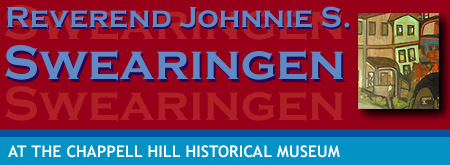
![]()
![]()
Reverend Johnnie Swearingen was born on August, 27, 1908, to parents Lemuel and Eula Swearingen, in Campground Church, an African American community near Chappell Hill, Texas. The Swearingens were sharecroppers, and Johnnie grew up dividing his time between farming and occasional schooling. In his early twenties he made his way to the West Coast, hopping trains and taking various temporary farming and construction jobs. He ended up in San Pedro, where he worked in the shipyards, and stayed there until 1948, when he returned and settled in Brenham. In 1949, he married Murray Williams, and once again took up farming.For many years, he divided his time between painting and cotton farming, selling his paintings from his front yard as well as from his pickup truck. He would drive into town, park where people driving along the highway that ran through town could see him, and sell his paintings there. Sometimes he would even nail the paintings to the side of his truck.
Swearingen was an artist from early in his life, drawing on whatever was at hand and painting with whatever materials he could find. A woman who worked at Perry's, a Five & Dime store in Brenham, said that, over time, he tried out every kind of paint the store sold, including model airplane paint. A number of the works in this collection began with a drawing done with a black marker with the paint applied over that. For the most part, though, he worked with oil paint on masonite, although late in his life he switched to canvas. He continued to paint until just prior to his death in January, 1993.
The paintings that form the collection of the Chappell Hill Historical Society were purchased from Swearingen in the early 1970s by Mr. and Mrs. Don Austin of Chappell Hill. The. Austins eventually accumulated more than sixty pieces, which Mrs. Austin donated to the Chappell Hill Historical Society in 1990 after the death of her husband.
At the time that this collection was assembled, Swearingen was not considered to be an important painter. It is possible that the Austins, and others in the community, bought them from Swearingen simply because they liked him, or they wanted to support a local artist, or maybe just because he was there. What is certain is that the paintings were treated casually, to say the least. Some of the damage to the surfaces was inflicted by Swearingen himself, who obviously stacked them front to back while they were still wet. The Austins stored them for years in a storage room. Because it is not known for certain what materials he used, cleaning them is risky, and they have therefore been left as-is.
The paintings in this collection mostly fall into four subject categories: local homes, local commercial and public buildings, agrarian activities, and leisure activities. There are, in addition, three paintings of the Hoover Dam and four paintings that were perhaps inspired by movie westerns. Swearingen was a religious man--he was ordained in 1965--and while many of his later paintings depict religious themes, there are none in this collection.
Swearingen painted both the physical and the spiritual worlds in which he lived, making the Chappell Hill collection a valuable historical document. Moreover, he is now widely recognized as an important Texas folk artist, and these paintings are a vivid document of his early artistic development.
Randy Franklin
Photograph of Johnnie Swearingen courtesy of John & Stephanie Smither
![]()
![]()
Copyright © 2000 Chappell Hill Historical Society - All Rights Reserved.
